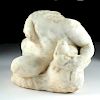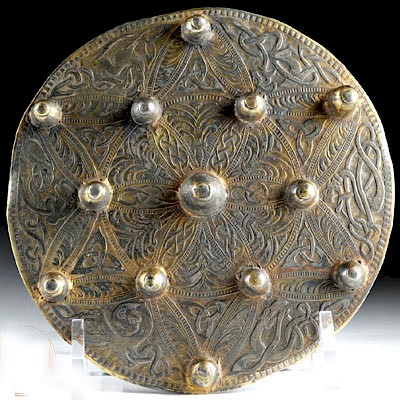Roman Marble Torso of Cherub
Lot 35b
About Seller
Artemis Fine Arts
686 S Taylor Ave, Ste 106
Louisville, CO 80027
United States
Selling antiquities, ancient and ethnographic art online since 1993, Artemis Gallery specializes in Classical Antiquities (Egyptian, Greek, Roman, Near Eastern), Asian, Pre-Columbian, African / Tribal / Oceanographic art. Our extensive inventory includes pottery, stone, metal, wood, glass and textil...Read more
Estimate:
$9,000 - $14,000
Absentee vs Live bid
Two ways to bid:
- Leave a max absentee bid and the platform will bid on your behalf up to your maximum bid during the live auction.
- Bid live during the auction and your bids will be submitted real-time to the auctioneer.
Bid Increments
| Price | Bid Increment |
|---|---|
| $0 | $25 |
| $300 | $50 |
| $1,000 | $100 |
| $2,000 | $250 |
| $5,000 | $500 |
| $10,000 | $1,000 |
| $20,000 | $2,500 |
| $50,000 | $5,000 |
| $100,000 | $10,000 |
| $200,000 | $20,000 |
About Auction
By Artemis Fine Arts
Jul 19, 2018
Set Reminder
2018-07-19 10:00:00
2018-07-19 10:00:00
America/New_York
Bidsquare
Bidsquare : Fine Antiquities/Ethnographic Art
https://www.bidsquare.com/auctions/artemis-gallery/fine-antiquities-ethnographic-art-3329
Featuring classical antiquities, ancient and ethnographic art from cultures encompassing the globe, plus fine art. Artemis Fine Arts info@artemisfinearts.com
Featuring classical antiquities, ancient and ethnographic art from cultures encompassing the globe, plus fine art. Artemis Fine Arts info@artemisfinearts.com
- Lot Description
Rome, Imperial Period, ca. 1st to 3rd century CE. A finely carved torso of a nude cherub, probably originally part of a sarcophagus. The body is depicted dynamically, turned towards the viewer, with the legs splayed, and one arm holding something round and a space for the hand that was clearly made as a separate piece (a common practice in Roman marble statuary). The cherub's body is chubby and childlike, with the sculptor emphasizing his ample body and rotund thighs. A delightful depiction, carved from a pretty piece of pale marble with a few faint grey bands through it. Size: 11.7" W x 7.25" H (29.7 cm x 18.4 cm)
In the 2nd century CE, sarcophagi became common in Rome, representing a shift from cremation to inhumation. These coffins could be made of wood, stone, lead, and, most luxuriously, marble. Most of these were low, rectangular shapes with flat lids, made to be placed on a wall or niche inside a mausoleum, so sides left visible would be highly decorated. Battle, hunting scenes, and mythological figures, like this one, were popular. It seems likely that individuals or their families commissioned specific subjects in order to commemorate the dead, and that artisans would have worked closely with them to realize their designs.
Provenance: private East Coast, USA collection
All items legal to buy/sell under U.S. Statute covering cultural patrimony Code 2600, CHAPTER 14, and are guaranteed to be as described or your money back.
A Certificate of Authenticity will accompany all winning bids.
We ship worldwide and handle all shipping in-house for your convenience.
#136167A fragment with losses as shown, earthen encrustation, and mineral deposits on the surface. What remains has nice detail and the form is very clear.Condition
- Shipping Info
-
All shipping is handled in-house for your convenience. Your invoice from Artemis Gallery will include shipping calculation instructions. If in doubt, please inquire BEFORE bidding for estimated shipping costs for individual items.
-
- Buyer's Premium



 EUR
EUR CAD
CAD AUD
AUD GBP
GBP MXN
MXN HKD
HKD CNY
CNY MYR
MYR SEK
SEK SGD
SGD CHF
CHF THB
THB
















